Shares of one-drug concern Aurinia Pharmaceuticals (NASDAQ:AUPH) have slumped more than 80% from their all-time high as sales of lupus nephritis medication Lupkynis have disappointed since its launch in 2021. Management has elected to solely focus its efforts on driving Lupkynis sales, laying off 25% of its sales force and discontinuing its other two discovery programs in February 2024. With positive cash flow expected in 2Q24, a highly underpenetrated market, a $150 million share repurchase in place, and plenty of cash on hand, Aurinia warranted further investigation. An analysis around Aurinia follows below.
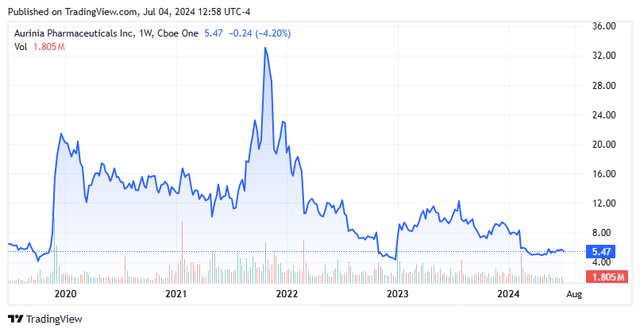
Seeking Alpha
Company Overview:
Aurinia Pharmaceuticals, Inc. is an Edmonton, Alberta,-based late-clinical stage biopharma focused on the treatment of kidney disease. The company is only active with one asset, marketing the first-ever FDA-approved oral therapy for lupus nephritis, calcineurin inhibitor [CNI] immunosuppressant Lupkynis (voclosporin), after it was approved in January 2021. Aurinia’s story somewhat begins with Isotechnika Pharma, which was founded in 1993 and has spent most of its efforts developing voclosporin, which it discovered in the mid-1990s. Aurinia was formed as a division of Vifor Pharma in 2012. Isotechnika went public on the Toronto Stock Exchange in 1999 and subsequently merged with Aurinia in 2013, shortly after providing it an exclusive license for voclosporin, essentially consolidating the rights to the then product candidate. Its stock was then dual listed on the Nasdaq in 2014. The stock sells for just under $5.50 a share, equating to an approximate market cap of $775 million.
Lupkynis
As can be gleaned from above, Lupkynis’ approval culminated a two-and-a-half-decade odyssey, with active ingredient voclosporin evaluated as a treatment for renal allograft rejection, non-infectious uveitis, psoriasis, and dry eye syndrome before receiving the green light for LN, an inflammation of the kidney caused by chronic autoimmune disease systemic lupus erythematosus (SLE). The renal damage caused by LN results in excess serum proteins (proteinuria) or blood (hematuria) in the urine and impaired kidney function. Severe LN can progress to end-stage renal disease within 15 years in 10%-30% of patients. SLE patients with renal damage have a significantly (14 to 60 times) higher risk of premature death. Up to 45% of SLE patients develop LN.
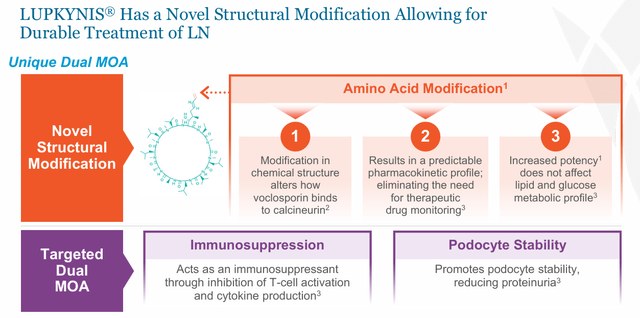
Company Presentation
Voclosporin is essentially a single amino acid modification of cyclosporin, another CNI immunosuppressant, which is approved for all the above indications (save LN) after receiving its first FDA approval in the early 1980s. By inhibiting calcineurin, these therapies reduce cytokine activation while blocking interleukin IL-2 expression and T-cell mediated immune responses. That one amino acid alteration increases voclosporin’s effectiveness, inhibits proteinuria, and allows for easier dosing.
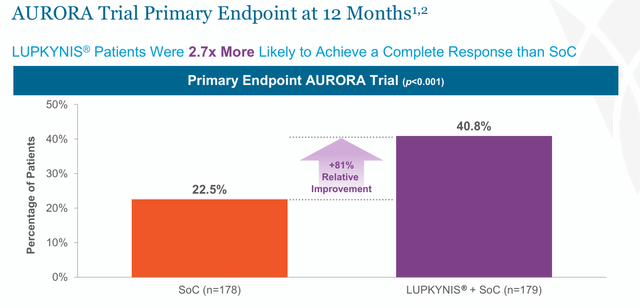
Company Presentation
Lupkynis was approved after meeting its primary endpoint in a 357-patient Phase 3 study (AURORA), with complete renal response rates at 52 weeks of 40.8% vs. 22.5% for placebo (Odds Ratio 2.65; p < 0.001) when added to background therapy of standard-of-care generic CellCept (mycophenolate mofetil or MMF), as well as initial treatment with IV methylprednisolone, followed by a reducing course of oral corticosteroids.
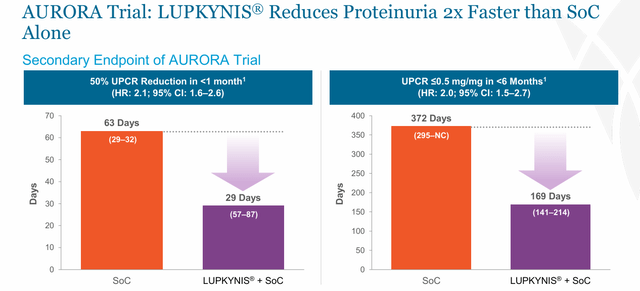
Company Presentation
Competitive Landscape and Commercial Results
Even though Lupkynis was the first-ever approved oral therapy for LN, GlaxoSmithKline’s (GSK) IV administered monoclonal antibody Benlysta’s (belimumab) label expansion into LN – already approved for SLE – came one month prior, marking the initial approval for the indication. Even though Aurinia’s therapy was arguably superior to Benlysta in both efficacy and administration, Glaxo’s small head start with an already established product in the middle of a pandemic, not to mention its enormous and entrenched marketing effort, has made Lupkynis’ uptake challenging. The therapy has also run into doctors prescribing a combination of MMF and steroids or first generation CNIs, like the generic version of Astellas Pharma’s (OTCPK:ALPMF) Prograf (tacrolimus).

Company Presentation
As such, Aurinia’s first three years of sales have been lackluster, posting FY21 domestic sales of $45.5 million in FY21, followed by $103.5 million in FY22 and $158.5 million in FY23. Even though the company estimates that due to underdiagnosis and undertreatment there are ~100,000 LN patients in the U.S., it’s achieved only ~1,791 new prescriptions in FY23. Approximately 85% of those convert to patients on treatment, with ~56% of those remaining on treatment after one year. With an annual price tag of ~$65,000, there were 2,178 patients on Aurinia’s med as of March 31, 2024, representing less than 3% of the estimated domestic market share. Owing to these tepid statistics versus initial expectations, the company’s share price has gradually eroded 84% from its all-time high of $33.97, which was achieved in November 2021 on the back of a reported 112% sequential increase in sales (3Q21 vs 2Q21) to $14.7 million, when hopes for deeper market penetration peaked.
There are two other reasons for the stock’s underperformance. The first has to do with Lupkynis’ IP, with its new chemical entity exclusivity set to expire in 2026, leaving it open to generic challenges as early as January 2025. Its composition of matter patent expired in 2022 and Aurinia has filed to extend that to 2027 – a currently ongoing process. The real patent issue hinges on two dosing protocol (method of use) patents that should extend protection to 2037. At a minimum, with the lengthy legal process inherent in IP challenges, no generics should enter the market until 2028. The bet here is that the company will eventually strike agreements with the manufacturers, allowing competition sometime between 2028 and 2037. This obviously important and uncertain matter is further amplified by the fact that there appears to be no meaningful clinical competition, especially on the oral front, to Lupkynis.
The second reason for the stock’s dismal performance is Aurinia’s failure to be sold after it hired JPMorgan to assess “strategic alternatives” in June 2023 – surprising considering Lupkynis’ perceived market under-penetration and the company’s Canadian gross net operating loss carryforwards of ~$560 million.
Restructuring
Unable to attract a suitor, management elected to scrap development of its preclinical M2 macrophage modulator asset (AUR300) and seek alternatives for its B-cell mediated autoimmune disease program (AUR200) in February 2024 that had received the green light to enter the clinic just one month prior to focus solely on reinvigorating Lupkynis, resulting in a 25% reduction in headcount. These moves are expected to save the company $50 million to $55 million per annum. To date, Aurinia’s marketing efforts have included multiple post-approval studies demonstrating Lupkynis’ superiority to alternatives. It did receive an updated label to reflect long-term data from AURORA in April 2024, although that development is not likely to move the sales needle significantly, except to improve the 56% persistency statistic after one year.
Otsuka Collaboration
The company also has an EU, UK, and Japan commercial collaboration with Otsuka Pharmaceuticals (OTCPK:OTSKF), from which it received $50 million upfront (in December 2020) and $40 million in milestone payments to date. Once Lupkynis obtains approval in Japan – expected in 2H24 – Aurinia will collect its final $10 million milestone, adding to the tired 10% to 20% royalties on net sales it receives from these territories.
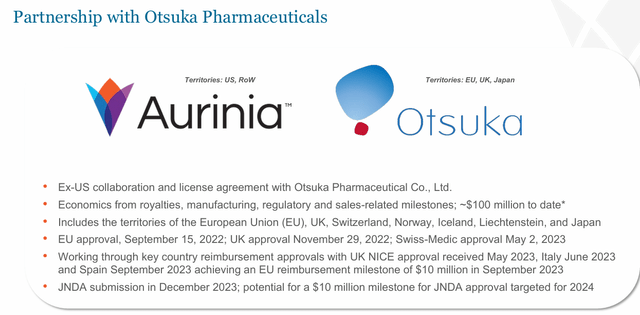
Company Presentation
1Q24 Corporate Update
Management’s actions were partly actuated to address its unprofitability, although its cash burn is not alarming. With little else going on at the company, it reported 1Q24 results on May 2, 2024, posting a non-GAAP loss of $0.03 a share on total net revenue of $50.3 million (domestic net product revenue of $48.1 million) vs. a loss of $0.18 a share (GAAP) on total net revenue of $34.4 million ($34.3 million) in 1Q23, representing 46% (40%) year-over-year growth at the top line and a $3.2 million beat vs. Street consensus. The improvement coincided with 26% more patients on Lupkynis at the end of 1Q24 as compared to the end of 1Q23. The non-GAAP/GAAP EPS difference reflected restructuring charges of $6.7 million in 1Q24.
Management reiterated its FY24 total revenue forecast of $200 million to $220 million, and owning to its restructuring, expects to be cash flow positive, save stock buybacks, in 2Q24. The market did not take notice to these developments, with shares of AUPH down $0.03 to $5.17 in the subsequent trading session.
Balance Sheet and Analyst Commentary:
Those aforementioned share repurchases, totaling $150 million, were authorized by Aurinia’s board as part of its restructuring and at current prices represent ~20% of the shares outstanding. Through April 30, 2024, management had bought back ~3.4 million shares with $131.4 million remaining on the program. The company has plenty of capital to execute on it, holding cash and investments of $320.1 million and no debt on March 31, 2024.
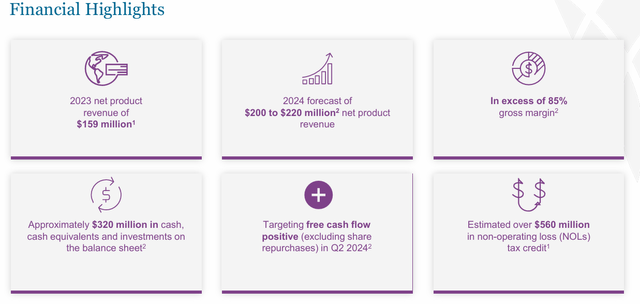
Company Presentation
The Street was largely on board with Aurinia before the restructuring announcement, with six buy or outperform ratings against Jeffries’ sole hold. Their median price objective is $10. On average, they anticipate the company earning $0.07 a share (non-GAAP) on total net revenue of $228.3 million in FY24, followed by $0.47 a share (non-GAAP) on total net revenue of $282.3 million in FY25.
Verdict:
With the company’s pivot towards profitability, shares of AUPH are cheap on a forward PE basis, trading at 11.5 times FY25E EPS. They’re also very attractive on a price-to-FY25E sales (net of cash) basis at 1.6. In addition, the company has over $550 million of net losses to carry over, which will dramatically reduce taxes as the company becomes profitable. Further buttressed by a fully funded share repurchase authorization, even as a one-drug concern with potential patent risk, Aurinia is significantly undervalued and deserving of at least a small investment.
Read the full article here



